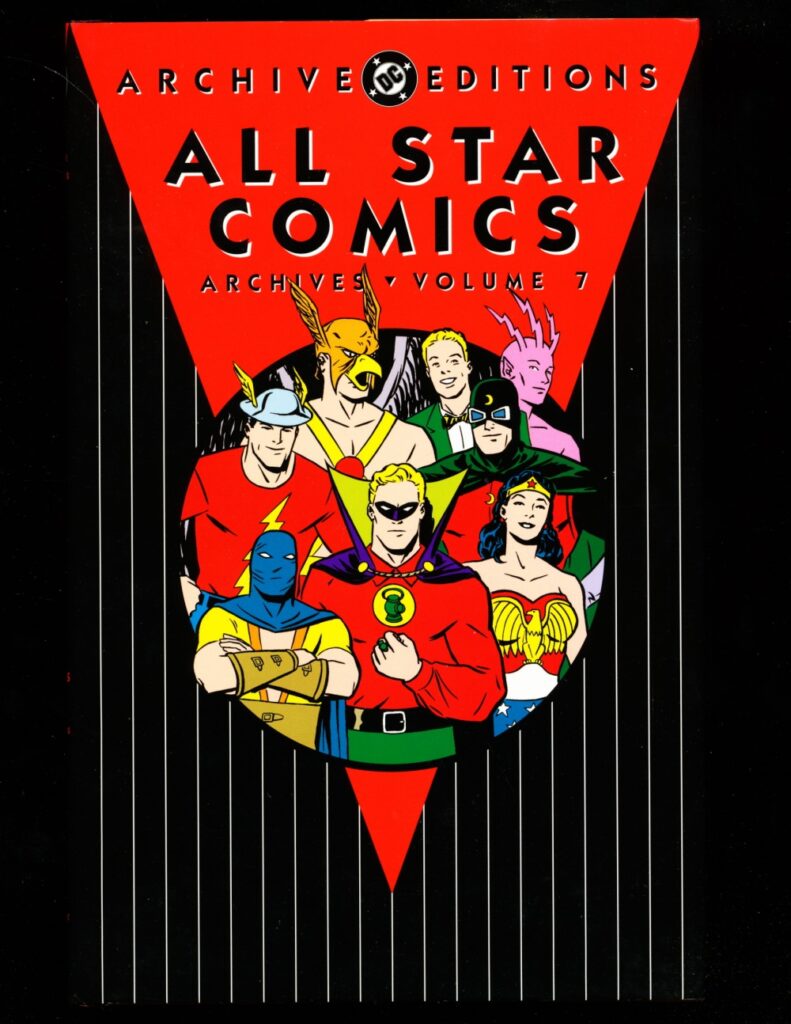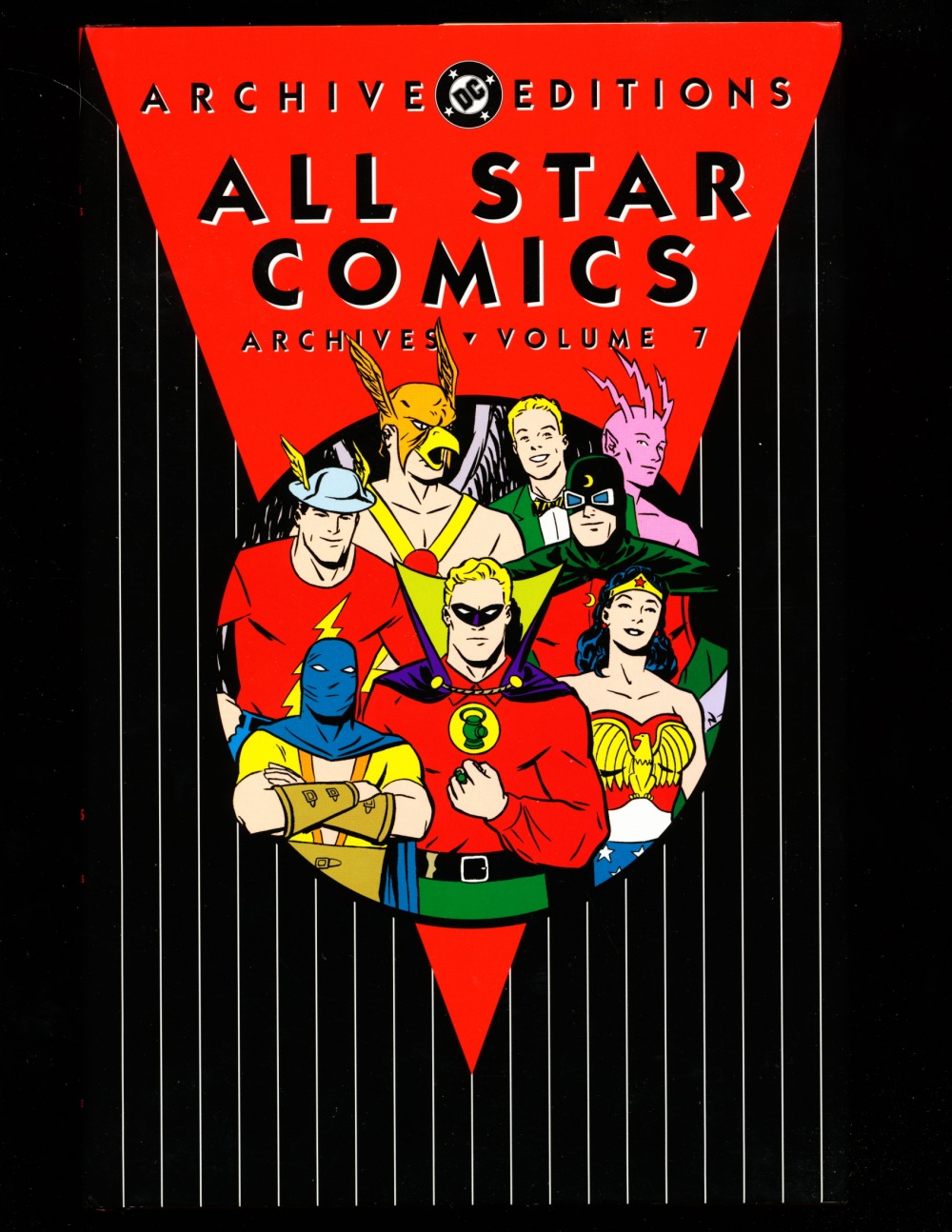Comic Book Review: All Star Comics Archives Volume 7 edited by Dale Crain
From All Star Comics #3 (Summer 1940) to All Star Comics #57 (March 1951), that comic book series was the home of the Justice Society of America, DC Comics’ first superhero team. This volume covers #29 (June 1946) to #33 (February 1947).

As discussed by Roy Thomas in his introduction, the membership of the JSA had stabilized for a while at seven members: Hawkman, Flash, Atom, Green Lantern, Dr. Mid-Nite, Johnny Thunder and Wonder Woman (secretary.) But due to publishing shenanigans, stories came up out of order, and this sometimes required rewrites and redraws. All the stories here are by Gardner Fox. Let’s take a look at what this volume has to offer!
#29 “The Man Who Knows Too Much” pits the Justice Society against Landor. Landor’s from the year 2445 where war, crime, poverty and other social ills have finally been licked. Life in this utopia would seem perfect, but Landor is a throwback who craves action and adventure. Having seen films of the JSA in action, he romanticizes the mid-20th Century and longs to live in that exciting time.
Landor filches some period clothing and a mothballed time machine from the local museum, ignoring the boxes of antique money just lying around (there are no guards because no one bothers to steal anymore.) He also doesn’t bring any of his 25th Century technology with him. (He reminds me of the Time Traveler from H.G. Wells’ The Time Machine for lack of forethought.)
The time machine hasn’t been maintained, and disintegrates on arrival. While Landor is pretty up on his science and technology skills, he never learned how to build a time machine. So he’s stuck in 1946, and quickly learns that you need money to get anywhere legally in America. He also doesn’t know how to access charity, so spends a couple days on the streets getting hungrier, more ragged and less able to think.
Johnny Thunder runs into Landor, and being a soft touch, treats the “homeless lunatic” to dinner. Landor explains his deal to the disbelieving Johnny. He turns an ordinary cigarette lighter into a glass-melting green flamethrower, but Johnny is distracted by a pretty waitress and doesn’t notice. Landor announces that the Sapphire State Building will vanish at two o’ clock today, but Johnny’s lost patience and ambles off.
Sure enough, the Sapphire State Building vanishes at two o’ clock in the afternoon. Landor issues a challenge to the Justice Society over an electric fan he’s turned into a radio transmitter. He’s going to do fantastic things at six sites, and dares the JSA to try to stop him. The six male members of the team each choose a location while Wonder Woman stays at their HQ to coordinate. (Sadly, none of the stories in this volume give WW more to do than this.)
Landor’s gimmick is that he has such a thorough understanding of future scientific and technological advances that he can kit-bash working super science gadget out of ordinary Twentieth Century items. A flashlight becomes a disintegrator, a washing machine becomes a force field generator, and so forth. He also cows a local criminal gang into working with him on the premise that he’s going to share some of the loot he’s gathering so his life of adventure can be lived in fun conditions.
Naturally, the heroes thwart each of his schemes, and at the end gather together to give him a proper thrashing. Landor is returned to the future (taking several hours of concentration by Green Lantern) a chastened man, ready to embrace a peaceful life where all have what they need.
#30 “The Dreams of Madness” had been written and drawn back when Starman and the Spectre had been on the team, while Green Lantern and Flash had not. So some quick rewriting and drawing was necessary to adapt it to the current cast, which can be spotted by a sharp eye. The Justice Society is contacted by Forest Malone, a scientist who has invented a dream recorder. He wants to record the JSA’s dreams for the advancement of science. Naturally, our heroes agree.
But as soon as the heroes are asleep in the machine, Malone reveals himself to actually be Henry King, the Brain Wave! The psychic villain had not in fact perished the last time they defeated him. The so-called “dream recorder” is actually a dream inducer. Each of the Justice Society members will be subjected to a customized nonsensical nightmare that will drive him mad!
So we get six imaginative scenarios which induce delusions in their target, for example making Dr. Mid-Nite think he’s a walking plague. Except that goofball Johnny Thunder is actually driven sensible. With the aid of his Thunderbolt and Brain Wave’s hubris, he’s able to capture the villain and restore his friends’ sanity. But in the aftermath Johnny takes a bump to the head and returns to goofball.
#31 “The Workshop of Willie Wonder” has the title toymaker possessed by a globe-shaped energy being named Zor of the Duna. He makes contact with the underworld and starts making them wonderful toys to commit crime with, verging on the magical.
The Justice Society is contacted by other members of the Duna. They’re worried that Zor will step up to ruling or even destroying the Earth once he gets bored with crime. These beings feel that directly controlling or harming sentient beings is wrong, so they need the JSA to fight the criminals and track down the current location of Zor. They follow the heroes invisibly.
My favorite chapter of this one is Green Lantern having to fight statues of Thor, Samson and Achilles that have the mythical powers of those individuals. It turns out at the end that Zor is a mental defective of the Duna species, their sane minds are far more powerful.
#32 “The Return of the Psycho-Pirate” brings back the original Psycho-Pirate, a small, meek-looking man with white hair and a droopy mustache. He has no actual powers but is a master of emotional manipulation. (This was the twist reveal at the end of his first appearance.) He was supposed to be in a story between his first and this one titled “The Will of William Wilson”, but that story was shelved for unknown reasons, and only partial art is still in existence.
This story starts some months ago, with the Psycho-Pirate sharing a cell with gang boss Big Mike. Big Mike expresses skepticism about the Pirate’s ability to commit crimes just by playing on people’s emotions, but the old man demonstrates by manipulating a guard to allow the prisoners to escape. Big Mike is impressed, and agrees to work for the Psycho-Pirate along with his gang.
Over the next little while, there are a number of crimes committed which play up various emotions, so the Justice Society is pretty sure the Psycho-Pirate is behind them, but can’t get enough evidence to trace his hiding place.
Big Mike, who wants to get revenge on the JSA for putting him away last time, gets impatient. He arranges for Johnny Thunder to stumble across a wallet containing partial plans for the gang’s next six plans. Then he tells the Psycho-Pirate this was accidentally leaked, and sells the leader on modifying the plans to also kill any hero that shows up.
This is my favorite of the stories in this volume. While the usual bad emotions like Pride and Anger are covered, there’s also crimes based on Curiosity and Humility, and focus not just on stopping the criminals but repairing the lives of those targeted. Plus the Psycho-Pirate runs the gamut of the emotional spectrum himself.
Amusingly, Johnny Thunder is the star of the Humility chapter, having been chastened enough to go about his investigation the correct way. He returns to his foolish ways by the end of the final chapter, though.
#32 “The Revenge of Solomon Grundy!” brings back one of the Green Lantern’s most dangerous foes. He’d once been miser Cyrus Gold, who was murdered in Slaughter Swamp outside Gotham City. Some strange chemical reaction turned his corpse into a zombie-ish creature with no conscious memory of who he’d been. Born on Monday, he’d named himself after the old nursery rhyme. Grundy is hostile to most humans, but especially to Alan Scott, the Green Lantern. Solomon Grundy is partially plant-based, so the power ring’s flame does not work well on him.
At the end of their last battle, Green Lantern had been able to trap Solomon Grundy in a near-indestructible force sphere. So now, it gets hit by lightning powerful enough to break the containment.
The Justice Society members enter their headquarters to find the place wrecked and Green Lantern missing. A huge muddy footprint matches Solomon Grundy’s, so he’s the obvious suspect. The team (except Wonder Woman) splits up to investigate towns he’s been rumored to appear in. Johnny Thunder gets to defeat a fake Grundy.
Eventually it turns out that Green Lantern escaped just before Solomon Grundy arrived, the swamp monster wrecked the place out of frustration, and Alan’s been in hiding ever since to guide the Society and Grundy to the right location. The whole team gangs up on Grundy to finally subdue him. Then Green Lantern puts him in another force sphere…on the moon. It would take a while for Solomon Grundy to get out of that fix.
There’s also the standard text stories in each issue. They’re very skippable.
This is a rather weak volume of the series. Gardner Fox seems to be phoning it in a few times, he barely acknowledges Wonder Woman is on the team, and other than Johnny, the main characters have no depth of personality. The first three stories also show the limits of having to split the team up for separate adventures each time which requires a different plot for each.
But the Psycho-Pirate story shows a lot more effort being put in, which helps immensely, and the Grundy story has some atmospheric moments. Oh, and Joe Kubert on Hawkman is good even in the early days.
Check out library loan to read the entire series! Recommended to Justice Society fans.

